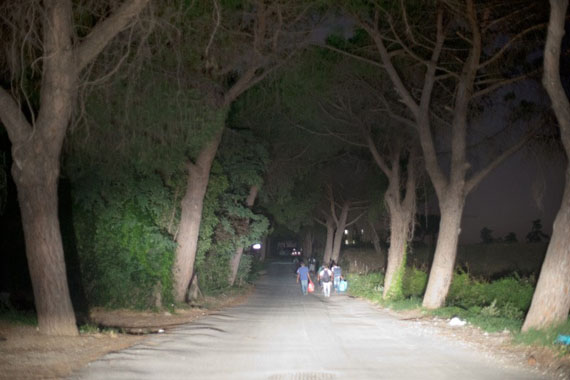
Deutscher Pavillon. La Biennale di Venezia 2015
Jasmina Metwaly / Philip Rizk » Olaf Nicolai » Hito Steyerl » Tobias Zielony »
Exhibition: 9 May – 22 Nov 2015
Thu 7 May 12:00

Concept
The German Pavilion has often acted as an artistic echo chamber for German history and identity. This year, the Pavilion’s large, quiet interior with its great height and accompanying sense of volume is a resonant space in which the productive sound of a globalized world can be heard. Starting from their varied reflections on the notions of “work”, “migration”, and “revolt”, the four artistic positions transform the building into a factory, into a vanished, virtual factory of the imagination, into a factory for political narratives and for analysing our visual culture.
The actors who populate the works by Olaf Nicolai, Hito Steyerl, Tobias Zielony, and Jasmina Metwaly/Philip Rizk are figures of revolt. We are confronted by these figures in all four works – be they theatrical, photographic, filmic, virtual, and/or physical in nature. The interpretation of the building’s verticality provides a number of different stages for this pavilion with its inherent spirit of resistance: ranging from a basement area all the way up to the roof. It is important too that the roof appears as a heterotope, as “another place”, in which freedom is evoked.
Olaf Nicolai puts the roof on show as the setting for a seven-months-long action. His protagonists perform a mysterious activity, a shadow economy enacted under a glistening sun. The choreography of his figures shifts focus between functional actions (or the actual production of an object) and the aesthetic dimension of what is done.
Hito Steyerl’s video installation “Factory of the Sun” shows a world in turmoil and a world of images on the move. It involves the translation of real political figures into virtual figures and an innovative experience of making and engaging with images, somewhere between a documentary approach and full-on virtuality. The new “digital light” is the main medium used to transfer what is left of reality into a circulating digital visual culture.
Tobias Zielony’s documentary essay consists of photographs that he took of African refugees in Berlin and Hamburg. On the one hand, they form an autonomous photographic narrative, on the other, they are the subjects of articles that African authors have published in newspapers in the protagonists’ countries of origin – in Sudan, Cameroon, and Nigeria.
The video installation by Jasmina Metwaly and Philip Rizk is an experimental chamber play in filmic form. For their film project “Out on the Street”, the artist duo invited Cairenes, both employed and unemployed, to an improvised studio on the roof of an apartment block, where they were encouraged to tell their own stories of relational power dynamics based on the premise of a factory that has been privatized and wound up.
If nothing else, the Pavilion can be read as a parable for the metamorphosis of visual media, from pictures as classical recordings to the generation, processing, and projection of images. It can also be seen as a statement about the changing use of images, which blurs the boundaries between document, testimony, and fiction.
Florian Ebner
Curator of the German Pavilion 2015
Head of the Photographic Collection, Museum Folkwang, Essen�

Konzept
Schon oft diente der Deutsche Pavillon als ein künstlerischer Echoraum deutscher Geschichte und Identität. In diesem Jahr ist der große stille Raum mit seiner enormen Höhe und dem entsprechenden Volumen ein Resonanzraum, in dem der Produktionstakt (productive sound) einer globalisierten Welt zu vernehmen ist. Ausgehend von ihrer unterschiedlichen Reflexion der Begriffe Arbeit, Migration und Revolte verwandeln die vier künstlerischen Positionen das Gebäude in eine Fabrik, in eine imaginäre, verschwundene, virtuelle Fabrik, in eine Fabrik der politischen Erzählungen und der Analyse unserer Bildkultur.<
Die Akteure, die die Arbeiten von Olaf Nicolai, Hito Steyerl, Tobias Zielony und des Künstlerpaars Jasmina Metwaly / Philip Rizk bevölkern, sind Figuren des Aufbegehrens und der Revolte. In allen vier Arbeiten begegnen sie uns, seien sie theatralischer, fotografischer, filmischer, virtueller und oder leibhaftiger Natur. Für diesen Pavillon des Aufbegehrens und der widerständigen Bilder stellt die vertikale Interpretation und Nutzung des Gebäudes gleich mehrere Bühnen bereit: von einer Art Basement bis hin zum Dach. Nicht zuletzt erscheint das Dach als Heterotopie, als ein „anderer Ort“, an dem sich Freiheit denken lässt.
Olaf Nicolai setzt das Dach als Schauplatz einer sieben Monate andauernden Aktion in Szene. Seine Protagonisten gehen dort einer rätselhaften Tätigkeit nach, einer Schattenökonomie unter gleißender Sonne. Die Choreografie seiner Figuren changiert zwischen funktionaler Handlung (der tatsächlichen Herstellung eines Objekts) und der ästhetischen Dimension dieses Tuns.
Hito Steyerls Videoinstallation „Factory of the Sun“ zeigt eine Welt in Aufruhr und eine Bilderwelt im Aufbruch. In ihr geht es um die Übersetzung realer politischer Figuren in virtuelle Figuren, um eine neuartige Erfahrung des Bildermachens und -erlebens zwischen dokumentarischer Haltung und völliger Virtualität. Das neue „digitale Licht“ ist das zentrale Medium des Transfers von den Resten des Realen in eine zirkulierende, digitale Bildkultur.
Tobias Zielonys dokumentarischer Essay besteht aus Fotografien, die er in Berlin und Hamburg von afrikanischen Refugees gemacht hat. Zum einen sind sie Elemente einer autonomen fotografischen Bilderzählung, zum anderen sind sie Gegenstand zahlreicher Artikel, die afrikanische Autoren in den Herkunftsländern der Protagonisten, im Sudan, in Kamerun und Nigeria, in Zeitungen veröffentlichten.
Ein filmisch-experimentelles Kammerspiel ist die Videoinstallation von Jasmina Metwaly und Philip Rizk. Für ihr Filmprojekt „Out on the Street“ hat das Künstlerpaar Kairoer Arbeiter und Arbeitslose in ein improvisiertes Studio auf dem Dach eines Wohnblocks eingeladen, um dort ihre eigene Geschichte von den Herrschaftsverhältnissen anhand einer privatisierten und abgewickelten Fabrik zu erzählen.
Nicht zuletzt lässt sich der Pavillon aber auch als eine Parabel für die Metamorphose von Bildern lesen, von Bildern im Sinne der klassischen Aufzeichnung (Recording) hin zur Generierung, Verarbeitung (processing) und Projektion von Bildern. Aber auch als Statement zu einem veränderten Gebrauch der Bilder, der die Grenzen zwischen Dokument, Zeugenschaft und Fiktion verwischt.
Florian Ebner
Kurator Deutscher Pavillon 2015
Leiter Fotografische Sammlung Museum
Folkwang, Essen�
